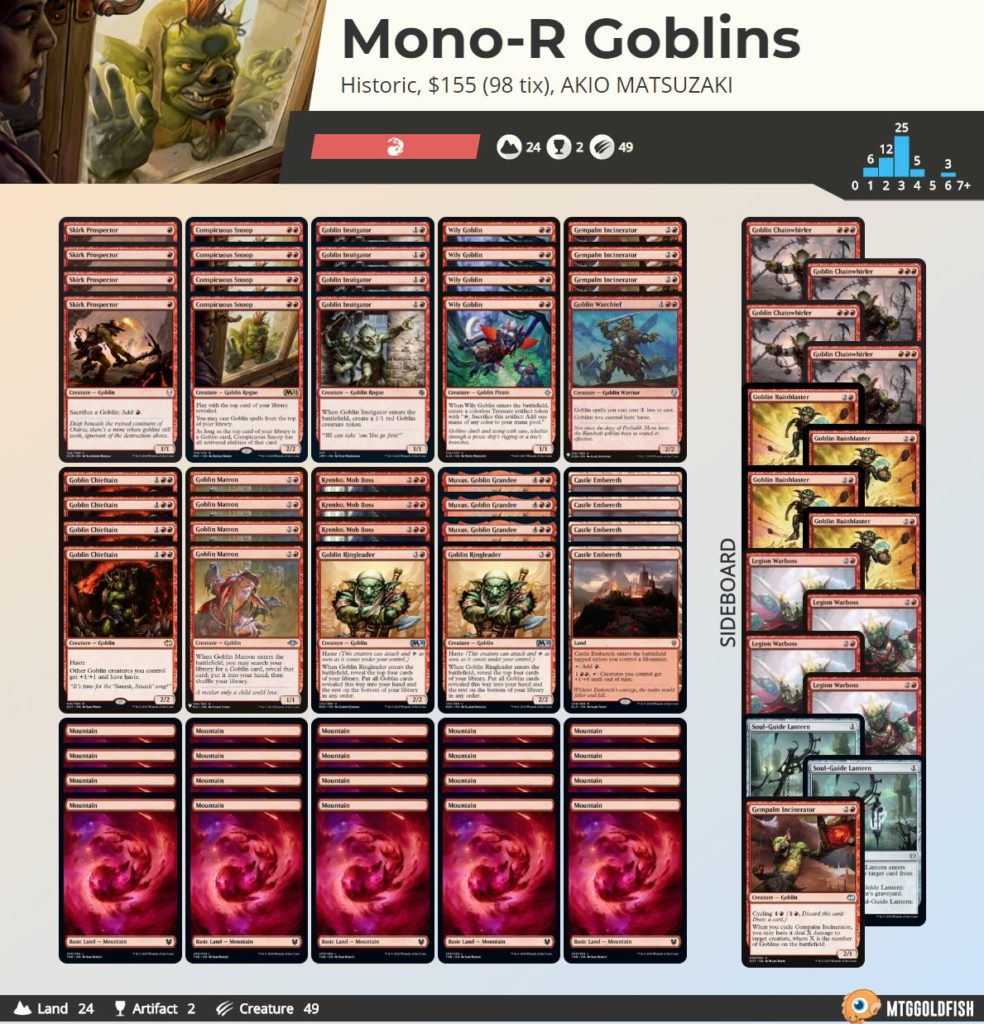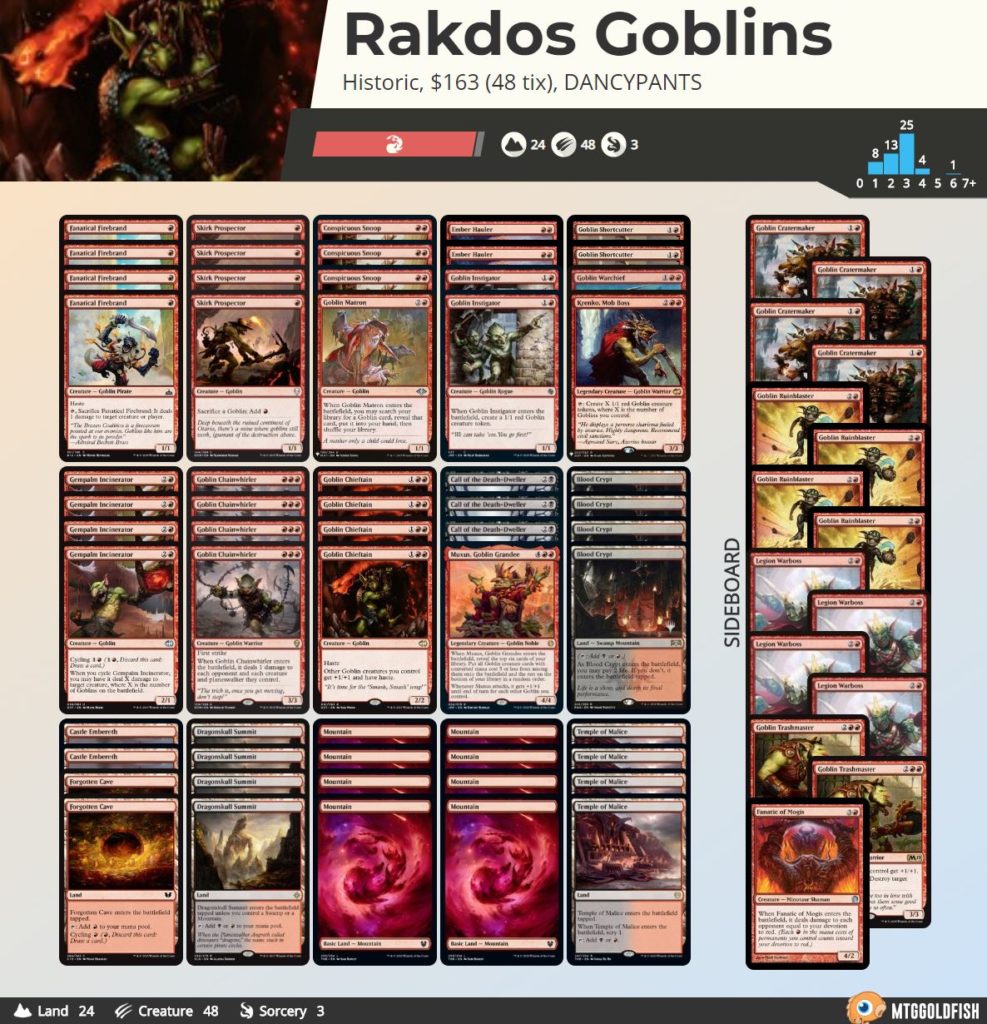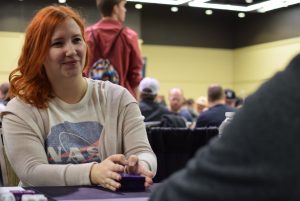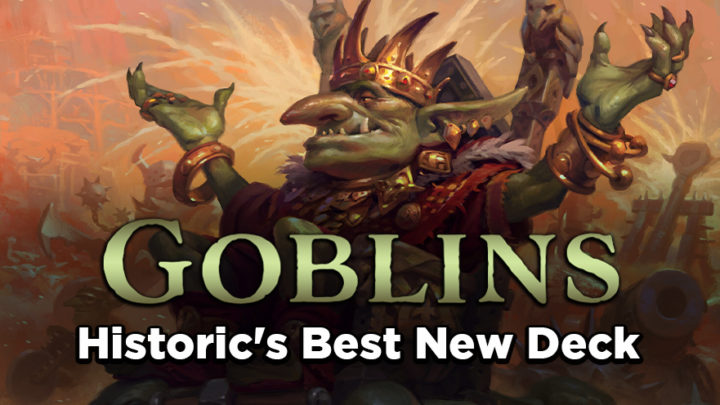Muxus is causing a ruckus. And while I can neither confirm nor deny that I wrote this article solely to make that pun, I can confirm that Goblins have been tearing up the Historic ladder, and a certain Goblin Grandee is making the archetype, well, grand. After playing the deck to Mythic myself, I thought I might break down what makes the deck tick, your options for building the archetype, and yes, even how to beat the little red terrors.
The Core Pieces
The core pieces of the powerful Goblins engine are Skirk Prospector, Goblin Chieftain, Goblin Warchief, Goblin Matron, and, of course, Muxus, Goblin Grandee.

Skirk Prospector might be the most overlooked and important combo piece in the deck. It allows you to play an early Muxus and spin through your less important Goblin cards with Conspicuous Snoop. Goblin Warchief also enables that early Muxus by reducing its casting cost, and Goblin Chieftain pumps the entire brigade, but most importantly, they both give haste, allowing Muxus and the slew of Goblins he brings with him to attack the turn they come down.

Goblin Matron helps ensure the deck is as consistent as possible. It tutors up any combo piece you need, and it can grab “answer” cards like Gempalm Incinerator, Goblin Trashmaster, and Goblin Ringleader. Normally, of course, you’ll likely be tutoring up the Goblin Grandee, as Muxus often wins the game on his own.
The following goblins are also auto-includes:
- Goblin Chainwhirler, which can keep the board clear of mana dorks or even opposing Goblins
- Goblin Instigator, which provides ample Skirk Prospector fodder and benefits from Goblin Chieftain pumps
- Krenko, Mob Boss, which can flood the board with tokens
- Fanatical Firebrand, a hasty little pinger to deal with one-off threats or help finish off opposing creatures or Planeswalkers

Export this decklist to Arena via MTGGoldfish!
Rebuilding After Board Wipes
While it’s important not to overcommit when playing against decks with board wipes (Azorius, Esper, and Jeskai Control come to mind), Goblins is uniquely suited to rebuild after disaster.

Let’s start with the most conspicuous card: Conspicuous Snoop. A good run of three or four Goblins in a row off the top of your library will usually put you back in a good position; it’s almost like Experimental Frenzy for Goblins! If your opponent tapped out for the Wrath and has no creatures of their own, a Goblin Warchief or Goblin Chieftain on top of the library just might win you the game on the spot.

Goblin Ringleader is still a leader in his own right (are you sick of these puns yet?), letting you refill your hand with two to four rabble-rousers. Since Ringleader itself has haste, you’ll usually get to chip in for two or more the turn you rebuild.

And of course, I’d be remiss not to mention the one, the only, Muxus! If you’re able to resolve Muxus at any point against a control strategy, you’re very likely to win. When up to six goblins pile straight onto the battlefield and Muxus gets +1/+1 for each other Goblin you control, it’s quite literally a lethal combination. And when you have eight creatures in the deck that give all Goblins haste, your opponent must have an answer for Muxus.
To Splash or Not to Splash
Would you believe me if I told you Goblins is actually a control deck? While it can have aggressive starts, Goblins often plays the “control” role against other creature-based strategies, such as Elves or Gruul.

Export this decklist to Arena via MTGGoldfish!
If you’re looking to play a more controlling game, I’ve found it’s best to splash black for Call of the Death-Dweller. When you return a Chainwhirler to the battlefield with a deathtouch counter, its chains are essentially dipped in poison. Suddenly, the board will be clear for your Goblin brigades to strike! If you time it just right, a Chainwhirler with deathtouch can even clear an opposing force of Zombies from Field of the Dead to let you attack in for the win.
More recent Goblins lists have been more combo-oriented, relying on Wily Goblin to rush out Muxus even sooner. These lists also play Krenko and Siege-Gang Commander to throw damage at opponents or generate tons of mana with Skirk Prospector.
Sideboard Options
In addition to some broadly playable Goblins, we also have access to some more niche sideboard options.

Goblin Ruinblaster is a standout for dealing with those pesky Field of the Dead decks. Goblin Cratermaker is uniquely suited to answer Ugin, the Spirit Dragon, while Goblin Trashmaster is perfect for any artifact strategies.

Our honorary Goblins include Bonecrusher Giant and Embereth Shieldbreaker. If you’re expecting a lot of mirror matches, Redcap Melee is a beautiful answer. You may also want to round out your sideboard with additional copies of cards from your main deck, like Gempalm Incinerator, Krenko, or Goblin Ringleader.
How to Beat Them
Goblins is an explosive deck, but like any creature-based strategy, it has its weaknesses. Sweepers like Shatter the Sky, Languish, Deafening Clarion and Cry of the Carnarium can do wonders to keep the board clear. I would recommend a mix of three- and four-mana answers; otherwise, you could be dead on your opponent’s turn four to a hasty Muxus or a combination of Goblin Chieftains and early threats. The deck also struggles against Mono-White Lifegain, as a turn one Soul Warden into a turn two Ajani’s Pridemate can quickly outpace a board of 1/1’s and 2/2’s.

If you’re not playing colors with access to board wipes, early interaction is key. You should prioritize — and even mulligan for — spells like Eliminate, Shock, and Lightning Strike. A Chainwhirler of your own also does a good job of not only cleaning up the board but holding off attacks. Alternatively, repeatable “pinging” effects like Mayhem Devil can make quick work of an army of Goblins. It’s not enough to bounce their cards with a Teferi, Time Raveler or a Brazen Borrower, as many have haste or enter-the-battlefield effects that minimize your tempo plays.

Additionally, as Goblins has evolved to consistently cast Muxus, cards like Grafdigger’s Cage become more potent. Cage also prevents you from playing Goblins off the top of your library with Conspicuous Snoop, which can inhibit your ability to rebuild after a board wipe.
Conclusion
In a few short weeks, this deck has already established itself as a pillar of the Historic format — and isn’t it Grand(ee)? Unfortunately, this has painted quite a target on the deck’s back; the format is already beginning to adapt, and Temur Reclamation (with access to board wipes like Storm’s Wrath) has been rising in popularity. However, with the format shifting so quickly, I expect Temur Reclamation decks to change their builds to be advantaged in the mirror, and when that happens, Goblins will be poised to strike once again.
Depending on how quickly the metagame shifts (or if you’re just a Goblin lover like me), I would definitely consider Goblins for best-of-one (if not best-of-three) ladder ranking, and potentially the upcoming Arena Open as well. Its explosive potential makes it a joy to play, and I’d recommend that anyone take it for a spin to understand how it works (and just how powerful it is). Who knows — you might just fall in love with it like I did.

A Spike at heart, Chantelle spends her free time prepping for tournaments, working toward the ever-elusive Mythic Championship, and championing other competitive ladies. She’s a combo aficionado and seasoned aggro deck player, and Standard and Modern are her preferred formats. Growing and improving as a player, both technically and in her mental game, are of the utmost importance to her.

